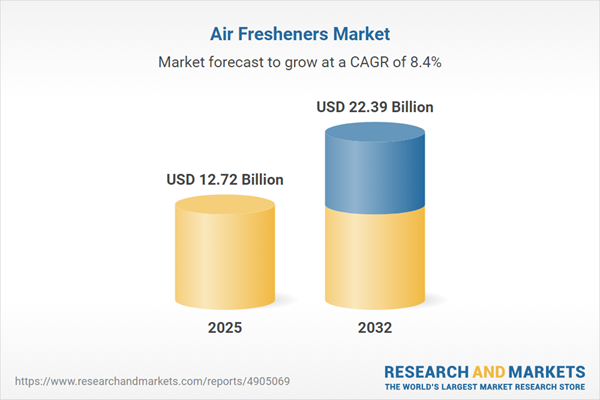Speak directly to the analyst to clarify any post sales queries you may have.
Senior decision-makers navigating procurement, strategy, or operations are encountering significant transformation in the global air fresheners market. Sustainability, wellness, and operational efficiency now guide the selection and integration of air care solutions, reflecting heightened stakeholder and regulatory priorities across regions and industries.
Market Snapshot: Global Air Fresheners Market Size and Growth
The global air fresheners market is valued at USD 11.78 billion in 2024, with expectations to grow to USD 12.72 billion in 2025 and reach USD 22.39 billion by 2032. This growth trend highlights robust demand across both commercial and residential settings. Key drivers shaping the market include increased awareness about indoor air quality, the integration of wellness-focused air care practices, and continuous innovation through smart technologies. Organizations and suppliers adopt regionally tailored strategies, setting competitive benchmarks in differentiation, compliance, and operational reach. These approaches allow institutional and consumer markets to refine user experiences and uphold evolving standards.
Scope & Segmentation in the Global Air Fresheners Market
- Product Types: Bead, candle, gel, liquid, and spray solutions are engineered for deployment in diverse spaces including offices, retail, hospitality, and home environments. Each type is designed to deliver optimal air quality, performance, and scent coverage.
- Fragrance Profiles: Floral, fruity, herbal, and woody options enable brands and facility managers to create tailored environments based on regional preferences and audience expectations, supporting enhanced guest and occupant experiences.
- Category: Wired and wireless air care devices emphasize ease of integration, meeting requirements for both large-scale facilities and residential applications. This flexibility simplifies operations and extends maintenance intervals.
- Distribution Channels: Organizations and consumers access air fresheners through supermarkets, pharmacies, convenience stores, and increasingly online platforms. This broad network supports efficient procurement and restocking processes.
- End Use Applications: Key deployment settings include hotels, office complexes, foodservice venues, and residential spaces. In commercial environments, air care supports cleanliness, ambiance, and customer satisfaction, while homeowners seek customizable, health-focused options.
- Regional Markets: The Americas, Europe, Middle East and Africa, and Asia-Pacific regions present varying regulatory landscapes and consumer behaviors. Successful market entry and performance demand adaptive strategies for compliance and preference alignment.
- Leading Companies: Influential players such as Aromate Industries, BALEV CORPORATION, Dabur India, Godrej Consumer Products, Henkel, PURESSENTIEL UK, Reckitt Benckiser Group, S. C. Johnson & Son, Procter & Gamble, and The Yankee Candle Company drive ongoing product development and influence global standards.
Key Takeaways for Strategic Leaders
- Prioritizing sustainable packaging and sourcing transparency improves supplier trust and underpins organizational environmental, social, and governance (ESG) initiatives across procurement channels.
- Implementing smart scent management technologies—such as digital and mobile controls—reduces administrative overhead, enhances operational visibility, and supports scalable air care strategies across multiple sites.
- Deploying modular scent systems offers differentiation for hospitality, retail, and service spaces, reinforcing brand identity and contributing to customer retention through targeted sensory environments.
- Leveraging collaboration with supply chain and technology partners accelerates innovation adoption and strengthens resilience in response to shifting regulations and air care trends.
- Adapting proactively to evolving sustainability standards and cross-border regulations limits compliance risks and safeguards access to scalable opportunities within the global air fresheners industry.
Tariff Impact: Preparing for Market Changes Post-2025
Expected tariffs on imported air care inputs and finished goods after 2025 are driving organizations to reconsider supplier relationships and sourcing models. Emphasizing local and regional production offers greater cost predictability and supply security in a dynamic economic climate. Adjustments in pricing and logistics are underway to mitigate volatility and protect commercial as well as consumer supply continuity.
Methodology & Data Sources
This market analysis synthesizes findings from secondary research, structured interviews with senior industry decision-makers, and comprehensive quantitative surveys. Validation by recognized industry experts ensures that insights remain actionable, reliable, and tailored to the needs of B2B air freshener stakeholders.
Why This Report Matters to B2B Leaders
- Enables strategic planning by providing actionable segmentation and region-specific insights, directly supporting efficient benchmarking and procurement decisions.
- Facilitates sustainability and digital transformation initiatives, equipping organizations to adapt sourcing, operations, and supply chain management to emerging expectations and priorities.
- Prepares executives to handle regulatory shifts, market instability, and supply chain complexities critical for maintaining competitive advantage and partnership value.
Conclusion
This comprehensive research offers senior leaders the intelligence and guidance necessary to make agile, future-ready decisions, supporting sustainable growth and market resilience in the evolving air fresheners sector.
Additional Product Information:
- Purchase of this report includes 1 year online access with quarterly updates.
- This report can be updated on request. Please contact our Customer Experience team using the Ask a Question widget on our website.
Table of Contents
3. Executive Summary
4. Market Overview
7. Cumulative Impact of Artificial Intelligence 2025
Companies Mentioned
The companies profiled in this Air Fresheners market report include:- Aromate Industries Co., Ltd.
- BALEV CORPORATION Ltd
- Dabur India Limited
- Godrej Consumer Products Limited
- Henkel AG & Co. KGaA
- PURESSENTIEL UK Ltd
- Reckitt Benckiser Group PLC
- S. C. Johnson & Son, Inc.
- The Procter & Gamble Company
- The Yankee Candle Company, Inc.
Table Information
| Report Attribute | Details |
|---|---|
| No. of Pages | 186 |
| Published | November 2025 |
| Forecast Period | 2025 - 2032 |
| Estimated Market Value ( USD | $ 12.72 Billion |
| Forecasted Market Value ( USD | $ 22.39 Billion |
| Compound Annual Growth Rate | 8.3% |
| Regions Covered | Global |
| No. of Companies Mentioned | 11 |









